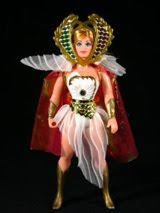This idea, "that the child is viewed as different," has led me to the following conclusions: (1) When teachers create these false images of kids, they are preparing themselves for nothing more than an enormous dose of reality - because when they enter the classroom - they will enter a new world where children are not as easily classified into their perceived constructions. THEREFORE, (2) I feel that in order to TEACH children, you MUST be on their level; you MUST be able to see through a different pair of eyes, not merely through the eyes of "adult."
 An awakening. I have awakened from a deep slumber of adulthood. As an "adult," I have read countless children's books. It was not until this semester - and a course called "reading and responding to children's literature - that I woke up. I realized through analysis of children’s literature, that children’s books must be read with an imagination (analysis is, in essence, this blog).
An awakening. I have awakened from a deep slumber of adulthood. As an "adult," I have read countless children's books. It was not until this semester - and a course called "reading and responding to children's literature - that I woke up. I realized through analysis of children’s literature, that children’s books must be read with an imagination (analysis is, in essence, this blog).In case anyone has forgotten, imagination is defined in the American Heritage Dictionary:
1. a. The formation of a mental image of something that is neither perceived as real nor present to the senses. 2. The ability to confront and deal with reality by using the creative power of the mind; resourcefulness.
I suppose one could say that I did have a sort of imagination before – based in constructed mental images of the child, as it was CLEARLY “neither perceived as real nor present to the senses” (see definition). On the other hand, this falsified definition of “child” may have been constructed by outside influences, i.e. media, pop culture, norms, …
Back to the point, a form of novice imagination has been regenerating inside MY MIND. Am I becoming more child-like myself, or have I developed a new found strategic ability to look at and analyze children’s literature? I would like to argue that both of the above have been occurring. There’s nothing wrong with getting younger, right? And remember, along with getting younger comes the imagination! AND with the imagination running rampant in my own mind, and the increased exposure to children’s literature, I can now exclaim, “I can read (again)!” And finally, I am digging deep into my own knowledge and my imagination (so child-like!?!?), as if to dig into the very core of literacy itself, to find REAL MEANING! Eureka!
I am feeling increasingly confident about enmeshing and utilizing my newly acquired skills of close observation, and the activation of my imagination while reading and responding to children’s literature into my future classroom. Literacy is a major goal of the education system in this country, and I am SO excited to begin putting my own knowledge and plans into action within the system. This is a new generation, READING can be an ADVENTURE.






































